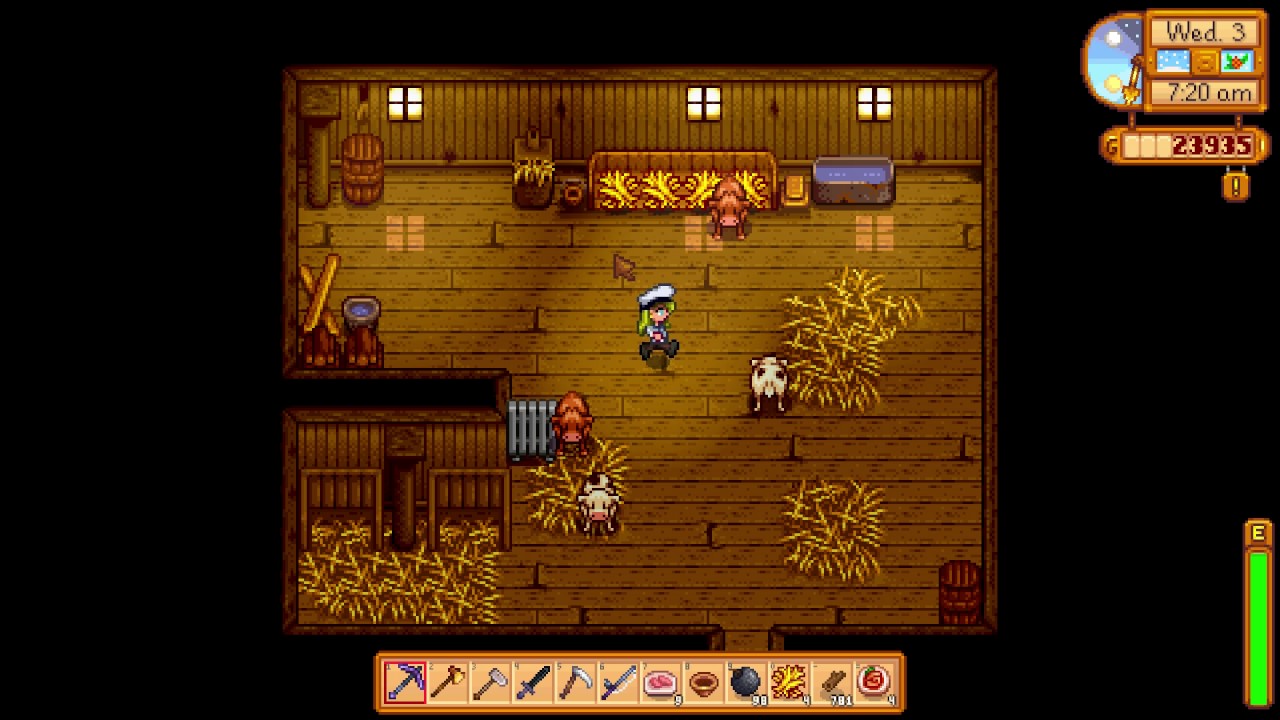Stardew Valley, the beloved farming simulation role-playing game, offers players the opportunity to raise a variety of animals on their farm. Proper animal care, especially feeding, is crucial for maintaining happy and productive livestock. This comprehensive guide will walk you through everything you need to know about feeding animals in Stardew Valley, from the basics to advanced strategies.
Contents
- 1 Understanding Animal Types and Their Feeding Requirements
- 2 Feeding Barn Animals (Cows, Goats, Sheep, and Pigs)
- 3 Feeding Coop Animals (Chickens, Ducks, and Rabbits)
- 4 Feeding Special Animals
- 5 Advanced Feeding Strategies
- 6 The Importance of Feeding for Animal Products
- 7 Seasonal Considerations for Feeding
- 8 Common Mistakes to Avoid
- 9 Tips for Efficient Animal Feeding
- 10 Frequently Asked Questions (FAQ)
- 11 Conclusion
Understanding Animal Types and Their Feeding Requirements
Before diving into the feeding process, it’s essential to understand the different types of animals you can raise in Stardew Valley and their specific feeding requirements.
Farm Animals
- Chickens
- Ducks
- Rabbits
- Cows
- Goats
- Sheep
- Pigs
Special Animals
- Dinosaurs (from Dinosaur Eggs)
- Void Chickens (from Void Eggs)
- Golden Chickens (rare mutation)
Each of these animals has unique feeding requirements and produces different products. Let’s explore how to feed each type of animal effectively.
Feeding Barn Animals (Cows, Goats, Sheep, and Pigs)
Barn animals are larger livestock that require a specific feeding routine to remain healthy and productive.
Hay: The Staple Diet
The primary food for barn animals is hay. Here’s how to ensure your animals have enough hay:
- Harvesting Hay:
- Use a scythe to cut grass on your farm
- Each grass cut has a chance to produce hay
- Upgraded silos increase the chance of hay production
- Storing Hay:
- Build silos to store hay automatically
- Each silo can store up to 240 pieces of hay
- Distributing Hay:
- Place hay in the feeding bench inside the barn
- Each animal consumes one piece of hay per day
Grazing: A Natural Alternative
During spring, summer, and fall, barn animals can graze outside if you leave the barn door open:
- Animals will eat grass instead of hay if available
- Ensure you have enough grass planted in their grazing area
- Use grass starters to plant more grass if needed
Winter Feeding
In winter, grass doesn’t grow, so you must rely entirely on stored hay:
- Ensure you have enough hay stored before winter begins
- Consider buying hay from Marnie if your supply runs low
Feeding Coop Animals (Chickens, Ducks, and Rabbits)
Coop animals have similar feeding requirements to barn animals, with a few key differences.
Hay for Coop Animals
Like barn animals, coop animals primarily eat hay:
- Place hay in the feeding bench inside the coop
- Each animal consumes one piece of hay per day
Grazing for Coop Animals
Chickens, ducks, and rabbits can also graze outside during non-winter seasons:
- Ensure there’s grass available in their outdoor area
- They will prefer grass over hay if both are available
Special Considerations for Ducks
Ducks have a unique preference:
- They enjoy swimming and will be happier if given access to water
- While not directly related to feeding, a happy duck produces better quality products
Feeding Special Animals
Dinosaurs
Dinosaurs, hatched from rare Dinosaur Eggs, have the same feeding requirements as other coop animals:
- They eat hay placed in the coop’s feeding bench
- Can graze on grass outside during non-winter seasons
Void Chickens
Void Chickens, obtained from Void Eggs, follow the same feeding pattern as regular chickens:
- Eat hay from the coop’s feeding bench
- Can graze on grass outside
Golden Chickens
Golden Chickens, a rare mutation, have the same dietary needs as regular chickens:
- Fed with hay in the coop
- Can graze on grass outside
Advanced Feeding Strategies
To maximize the happiness and productivity of your animals, consider these advanced feeding strategies:
1. Automate Hay Distribution
Upgrade your barns and coops to auto-feed your animals:
- Deluxe Barn and Deluxe Coop come with auto-feeders
- Auto-feeders automatically distribute hay to feeding benches
2. Optimize Grazing Areas
Design your farm layout to maximize grazing efficiency:
- Create dedicated grazing areas near barns and coops
- Use fences to control grazing and prevent animals from wandering too far
3. Rotate Grazing Spots
To prevent overgrazing:
- Divide your grazing area into sections
- Rotate which section animals have access to each week
- This allows grass to regrow in unused sections
4. Supplement with Treats
While not necessary for basic feeding, treats can increase animal happiness and friendship:
- Wheat for cows and goats
- Corn for chickens and ducks
- Apples for horses
- Give treats by holding the item and right-clicking on the animal
The Importance of Feeding for Animal Products
Proper feeding directly impacts the quality and quantity of animal products:
| Animal | Product | Impact of Proper Feeding |
|---|---|---|
| Chickens | Eggs | Higher quality eggs, potential for large eggs |
| Ducks | Duck Eggs | Better quality eggs, faster production |
| Rabbits | Wool | Higher quality wool, more frequent production |
| Cows | Milk | Larger milk quantities, better quality |
| Goats | Goat Milk | Higher quality milk, more consistent production |
| Sheep | Wool | Better quality wool, faster regrowth |
| Pigs | Truffles | More frequent truffle finding (when outside) |
Seasonal Considerations for Feeding
Each season in Stardew Valley presents unique challenges and opportunities for animal feeding:
Spring
- Start replenishing your grass supply
- Begin letting animals out to graze
- Plant plenty of grass starters for summer growth
Summer
- Peak grazing season
- Ensure ample grass growth to support all animals
- Start stockpiling hay for winter
Fall
- Continue grazing, but start relying more on hay
- Focus on maximizing hay storage before winter
Winter
- Rely entirely on stored hay
- No grass growth, so outdoor grazing is not possible
- Monitor hay supplies closely and purchase from Marnie if needed
Common Mistakes to Avoid
When feeding animals in Stardew Valley, be sure to avoid these common pitfalls:
- Forgetting to close barn/coop doors: Animals left outside overnight can be attacked by wild animals
- Neglecting to check hay supplies: Running out of hay leads to unhappy, unproductive animals
- Overgrazing: Not managing grass growth can lead to insufficient grazing areas
- Ignoring animal happiness: Unhappy animals produce lower quality products
- Forgetting about animals in winter: It’s easy to neglect animals when you can’t see them grazing outside
Tips for Efficient Animal Feeding
To streamline your animal care routine:
- Develop a daily habit of checking animal feed levels
- Invest in auto-feeders as soon as possible
- Keep a close eye on your silo capacity and hay stocks
- Plant grass starters strategically around grazing areas
- Consider building multiple silos for larger farms
Frequently Asked Questions (FAQ)
To conclude this guide, let’s address some common questions about feeding animals in Stardew Valley:
Q: Do animals die if I don’t feed them?
A: No, animals in Stardew Valley don’t die from lack of food, but they will stop producing and their friendship level will decrease.
Q: Can animals eat any other crops besides grass?
A: In terms of grazing, animals only eat grass. However, you can give them certain crops as treats to increase friendship.
Q: How do I know if my animals are hungry?
A: Check the feeding bench in their barn or coop. If it’s empty and the animals have angry faces, they’re hungry.
Q: Does the quality of hay affect animal products?
A: No, all hay is of the same quality. What matters is that the animals are fed consistently.
Q: Can I overfeed my animals?
A: No, animals will only eat what they need each day. Any excess hay will remain in the feeding bench.
Q: Do I need to feed my animals on festival days?
A: Yes, animals need to be fed every day, including festival days and your wedding day.
Q: How much grass do I need to plant for grazing?
A: A good rule of thumb is to have at least 2-3 times as many grass tiles as you have animals.
Conclusion
Feeding animals in Stardew Valley is a crucial aspect of farm management that directly impacts your farm’s productivity and profitability. By understanding the feeding requirements of different animals, implementing efficient feeding strategies, and avoiding common mistakes, you can ensure that your livestock remains happy and productive throughout all seasons.
Remember that animal care goes beyond just feeding – pay attention to their happiness, give them attention and treats, and create a comfortable environment for them. With proper care and feeding, your animals will reward you with high-quality products and contribute significantly to your farm’s success.
Whether you’re a newcomer to Stardew Valley or a seasoned farmer looking to optimize your animal care routine, we hope this comprehensive guide helps you master the art of feeding animals in the game. Happy farming!

Alma J. Lillard is a passionate writer and gaming enthusiast who brings her deep love for Stardew Valley to every piece she creates. As a contributor to StardewUpdate.Today, Alma covers the latest updates, tips, and in-depth guides for players looking to enhance their Stardew Valley experience.


1 thought on “How to feed animals in stardew valley game”
Comments are closed.